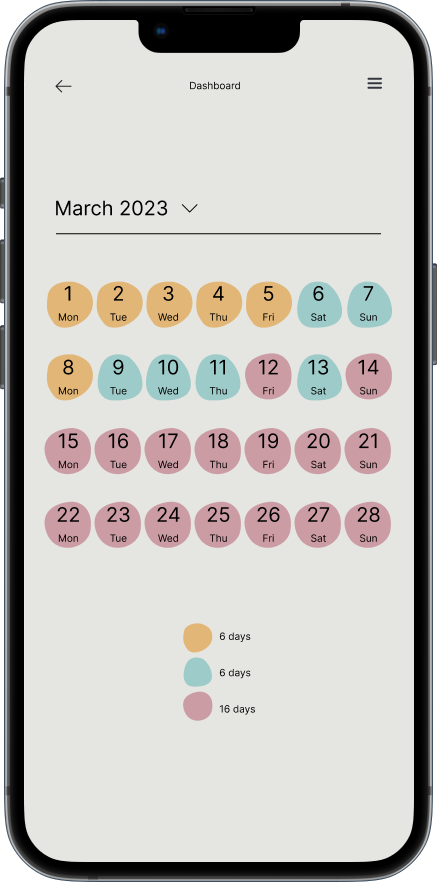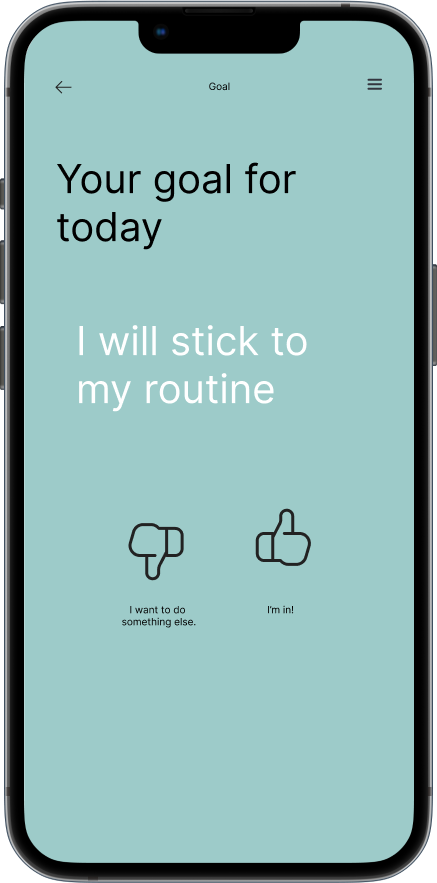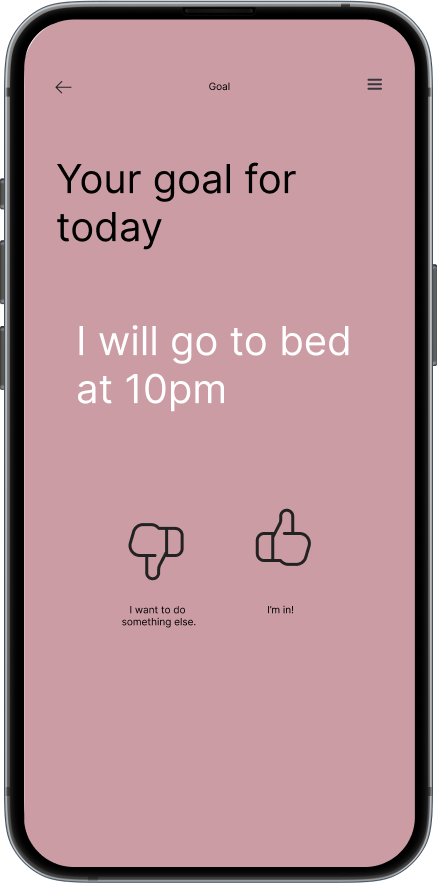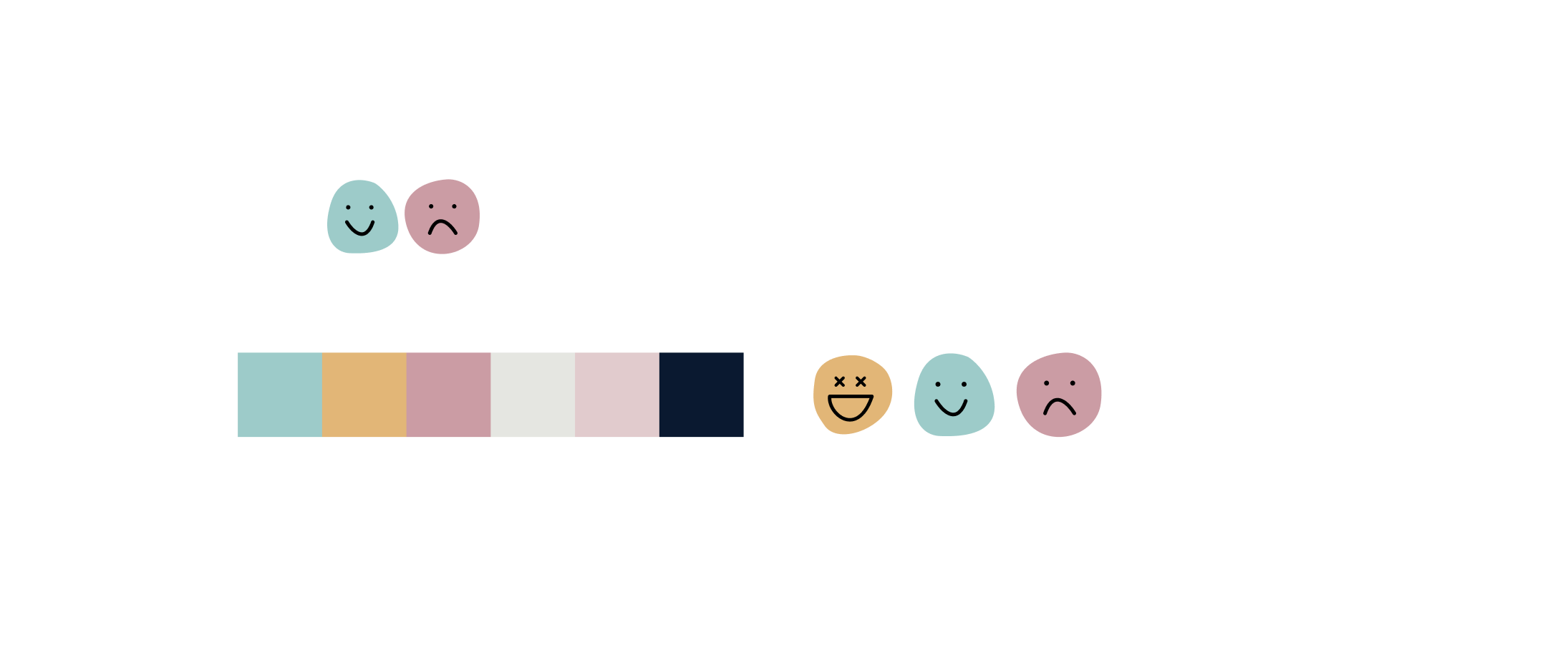MOODMASTER
APP
_Work in Progress
MoodMaster is an app tailored for individuals with bipolar disorder.
Psychological Idea
CBT/DBT
Gamification






INTRO
MoodMaster is a mobile application designed to empower individuals with bipolar disorder to effectively manage their mood and enhance their emotional well-being. The app incorporates evidence-based therapeutic techniques, including cognitive-behavioral strategies, to provide users with a comprehensive toolkit for mood management.
MoodMaster is a mobile application designed to empower individuals with bipolar disorder to effectively manage their mood and enhance their emotional well-being. The app incorporates evidence-based therapeutic techniques, including cognitive-behavioral strategies, to provide users with a comprehensive toolkit for mood management.
PROJECT GOALS
- Create a user-friendly mobile app that supports individuals with bipolar disorder in tracking and managing their mood.
- Integrate cognitive-behavioral therapy (CBT) principles into the app's design to empower users to identify and address mood-related challenges.
- Develop an engaging and supportive user experience to encourage regular use and long-term engagement.
- Prioritize user privacy and data security to maintain trust and compliance with healthcare regulations.
I structured the design process following the double diamond framework.

RESEARCH
Our team conducted extensive user research, including interviews, surveys, and competitor analysis of existing mental health apps. We gathered insights into the needs, challenges, and preferences of individuals with bipolar disorder.
KEY FINDINGS
importance of
importance of
- mood tracking
-
goal setting
- personalized support
SPECIFIC DEMANDS OF BIPOLAR DISORDER
Mood Sensitivity
Cognitive Variability
Goal Flexibility
Supportive and Positive Messaging
User-Controlled Notifications
Personalization and Mood-Based Features
- During manic phases, individuals may be more susceptible to sensory stimuli, so it's crucial to avoid design elements that could trigger or exacerbate their symptoms.
Cognitive Variability
- Bipolar disorder often leads to significant cognitive variability between depressive and manic phases. Users may have different levels of concentration, memory, and cognitive functioning.
Goal Flexibility
- Goals set during manic phases may not be realistic or achievable during depressive phases, and vice versa.
Supportive and Positive Messaging
- Self-care and treatment adherence are vital aspects of managing bipolar disorder. Positive and supportive messaging helps users stay engaged and motivated in their mood management journey.
User-Controlled Notifications
- Manic phases can lead to increased distractibility and impulsivity. Notifications can be overwhelming for users during manic phases when they may already have a high volume of thoughts and activities
Personalization and Mood-Based Features
- Bipolar disorder is characterized by mood fluctuations, and different strategies may be more effective during different mood states.
SYNTHESIS
USER PERSONAS
We created user personas based on our research to represent the diverse needs and preferences of our target audience.
We created user personas based on our research to represent the diverse needs and preferences of our target audience.
These three user personas represent different stages and aspects of living with bipolar disorder, from active management to seeking support and caregiving.

The Proactive Mood Tracker
Sarah is a 32-year-old marketing professional living in a busy urban area. She was diagnosed with bipolar disorder a few years ago.
Sarah is a 32-year-old marketing professional living in a busy urban area. She was diagnosed with bipolar disorder a few years ago.
GOALS
Sarah aims to proactively manage her mood fluctuations to lead a balanced life. She wants to identify triggers and early warning signs of mood episodes.
Sarah aims to proactively manage her mood fluctuations to lead a balanced life. She wants to identify triggers and early warning signs of mood episodes.
NEEDS
- Mood tracking features to record daily mood fluctuations and identify patterns.
- CBT-based exercises to challenge and reframe negative thought patterns.
- Goal-setting tools to establish and work towards maintaining mood stability.
CHALLENGES
Sarah struggles with consistency in mood management during manic and depressive episodes. She needs an app that can adapt to her varying energy levels and cognitive capacity.
Sarah struggles with consistency in mood management during manic and depressive episodes. She needs an app that can adapt to her varying energy levels and cognitive capacity.

The Newly Diagnosed Seeker
Alex is a 24-year-old college student who was recently diagnosed with bipolar disorder. They are still learning about their condition and treatment options.
Alex is a 24-year-old college student who was recently diagnosed with bipolar disorder. They are still learning about their condition and treatment options.
GOALS
Alex wants a user-friendly and informative app to help them understand and manage their bipolar disorder effectively.
Alex wants a user-friendly and informative app to help them understand and manage their bipolar disorder effectively.
NEEDS
- Clear and educational content explaining bipolar disorder and its management.
- Mood tracking to monitor and gain insights into their mood fluctuations.
- Access to a supportive community to connect with others who have similar experiences.
CHALLENGES
Alex is navigating the emotional and practical challenges of a new diagnosis. They need an app that offers guidance, support, and hope.
Alex is navigating the emotional and practical challenges of a new diagnosis. They need an app that offers guidance, support, and hope.

The Caregiver and Supporter
Chris is a 40-year-old teacher and a loving spouse to someone with bipolar disorder. While not living with the condition themselves, they play a vital role in supporting their partner.
Chris is a 40-year-old teacher and a loving spouse to someone with bipolar disorder. While not living with the condition themselves, they play a vital role in supporting their partner.
GOALS
Chris wants to actively support their partner's mood management journey and learn how to be a better ally.
Chris wants to actively support their partner's mood management journey and learn how to be a better ally.
NEEDS
- Access to educational resources to understand bipolar disorder and its impact.
- Tools to help their partner track mood fluctuations and set goals.
- Tips and strategies for providing emotional support and managing challenges together.
CHALLENGES
Chris faces the challenge of supporting their partner effectively while maintaining their own well-being. They need an app that offers guidance for both the individual with bipolar disorder and the caregiver.
Chris faces the challenge of supporting their partner effectively while maintaining their own well-being. They need an app that offers guidance for both the individual with bipolar disorder and the caregiver.
DESIGN
USER FLOW / WIREFRAMES
We created low-fidelity wireframes to map out the app's layout and user flow.
We created low-fidelity wireframes to map out the app's layout and user flow.
 _excerpt
_excerpt
_excerpt
VISUAL DESIGN
- The visual design prioritizes simplicity, clarity, and a calming color palette.
- Custom icons and graphics were designed to convey a sense of emotional support and empathy.

COGNITIVE-BEHAVIOURAL TECHNIQUES
- We integrated CBT principles into the app, including thought record exercises, mood journaling, and goal-setting features.
- The app offers personalized feedback and suggestions based on user input.

PRIVACY AND SECURITY
- Robust data security measures were implemented to protect user information.
- We created a transparent privacy policy and provided in-app explanations of data usage.
USABILITY TESTING
We conducted multiple rounds of usability testing with individuals living with bipolar disorder to gather feedback and make iterative improvements.
We conducted multiple rounds of usability testing with individuals living with bipolar disorder to gather feedback and make iterative improvements.
SPECIFIC DEMANDS OF BIPOLAR DISORDER
+ translation into design elements
Mood Sensitivity
- Be mindful of the potential impact of design elements (colors, fonts, animations) on users' moods. Avoid overly stimulating or triggering visuals, especially during manic phases.
︎︎︎ The visual design prioritizes simplicity, clarity, and a calming color palette.
︎︎︎ Custom icons and graphics were designed to convey a sense of emotional support and empathy.

Cognitive Variability
- Recognize that cognitive functioning can vary significantly depending on the individual's mood state (depressive or manic). Design for flexibility, allowing users to adapt the app to their current cognitive capacity.
︎︎︎ The user as the choice to pick or not pick certain exercises and goals.

Goal Flexibility
- Allow users to set flexible goals that can be adjusted based on their mood fluctuations. Acknowledge that goals set during a manic phase may need to be revisited during depressive phases.
- Consider incorporating features that adapt based on the user's mood state. For example, during depressive phases, the app could suggest self-care activities, while during manic phases, it might emphasize stress reduction techniques.
︎︎︎ The daily engagement with the app starts with the mood tracker. Depending on the mood the person picks, the suggested goal and exercises for the day are chosen accordingly.

Supportive and Positive Messaging
- Use supportive and encouraging language throughout the app. Provide motivational feedback and reinforce the importance of self-care and treatment adherence.
︎︎︎ Imagery and iconography are empathetic and emotional through the use of emojis and hand gestures.
User-Controlled Notifications
- Allow users to customize notification settings to avoid overwhelming them with reminders or alerts during manic phases.
FINAL PROTOTYPE
The final prototype of MoodMaster is a user-friendly and empathetic mobile app that seamlessly integrates mood tracking, CBT techniques, and goal-setting features.






CONCLUSION
MoodMaster is a testament to the power of user-centered design in creating digital tools that have a meaningful impact on individuals' lives. By integrating evidence-based therapeutic techniques and prioritizing user privacy, we have successfully developed an app that empowers individuals with bipolar disorder to take control of their mood and well-being.